Sony DSLR-A100H, DSC-W80, DSC-W55BDL, DSC-W35, DSC-W200 Guide
...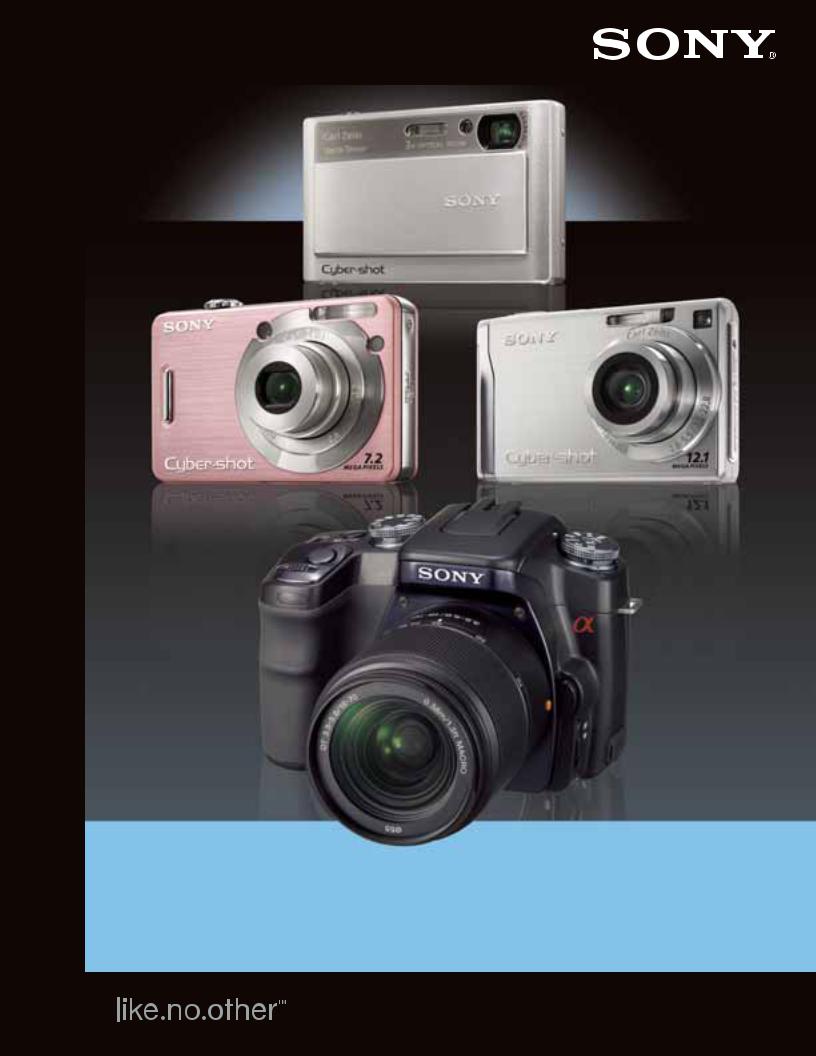
Guide to Digital Photography
Spring 2007
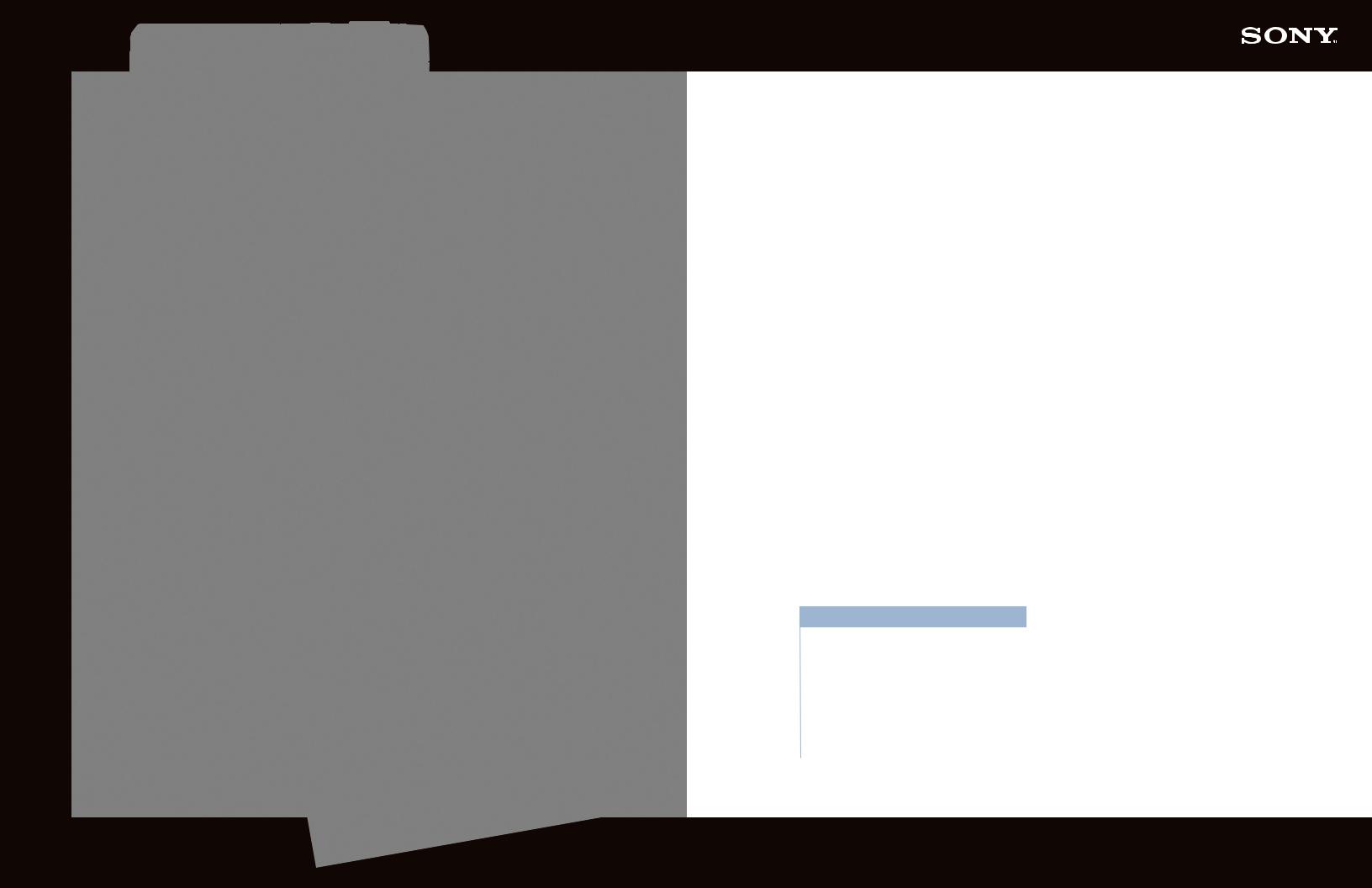
Getting the shot you really want.
Any camera will take pictures. Sony® cameras are designed to help you take great pictures – even when the circumstances are less than great. Sony cameras shine when the light is low. When subjects are distant. Or moving quickly. Sony uses the latest digital technology to help you get the shot you really want.
Sony innovation comes from a mastery of all things digital, from the sensors that capture your picture to the processor that manages it to the media that stores it to the battery that powers the entire system. Backed by these vast resources, we’re free to create digital cameras that change the way you see the world.
This guide tells you what you need to know about digital photography and digital photo printing. Along the way we’ll point out the unique Sony features that help you get the results you’re looking for.
CONTENTS
Getting the shot you really want |
2 |
Shooting the digital way: Camera systems |
16 |
Taking your best shot: Camera control |
34 |
Sharing your pictures |
44 |
Sony product guide |
50 |
Digital still camera specifications |
54 |
Index |
56 |
Television and monitor pictures simulated.
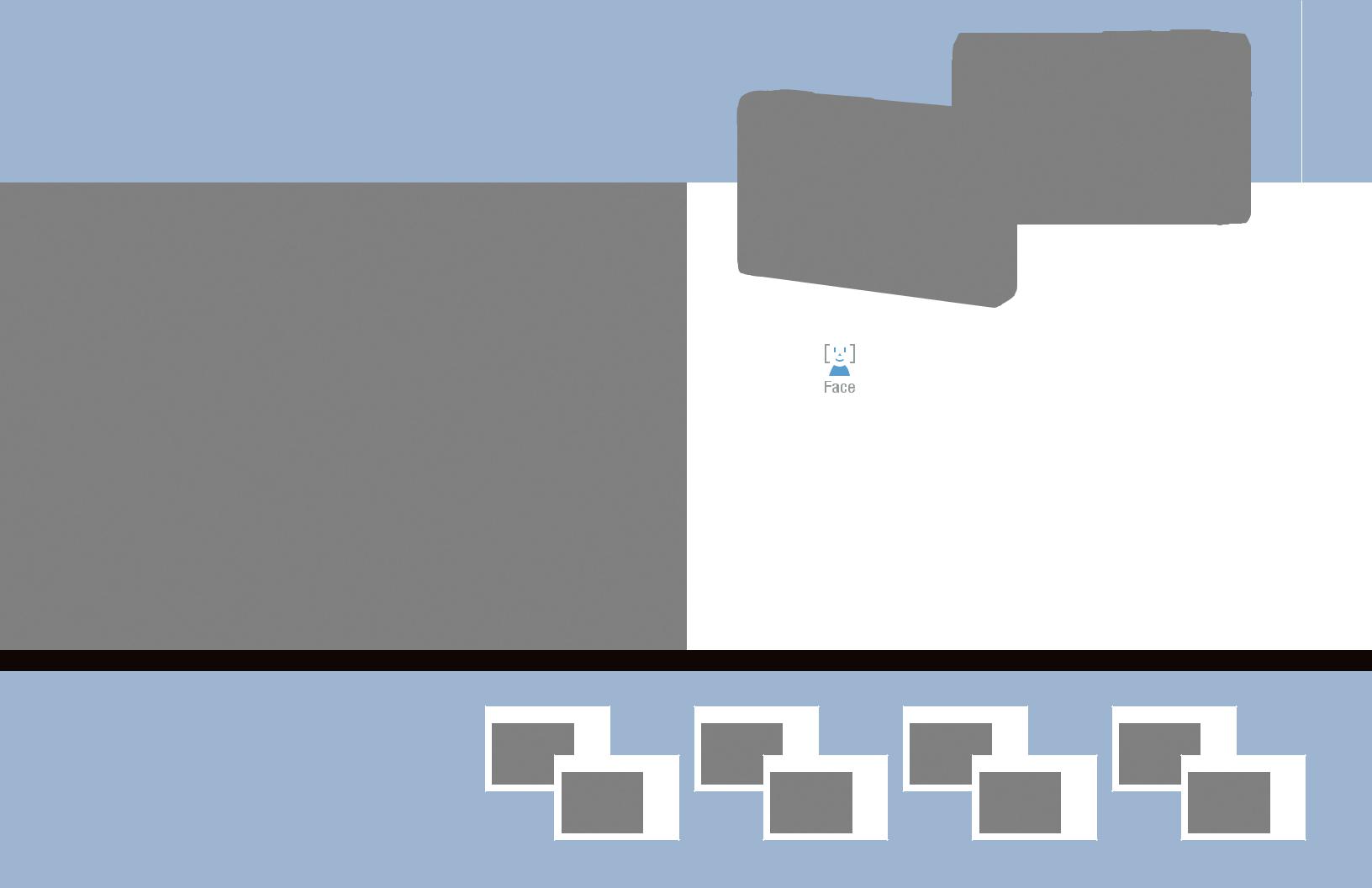
Face Detection
Friends and family will look their best because Sony has taught cameras
how to recognize – and optimize – the human face.
 W200-DSC
W200-DSC
FACE DETECTION
Sony solves common exposure, focus, flash
and white balance problems with Face
Detection technology. (Sample photos for
illustration purposes.)
See page 26 for details
or visit www.sony.com/dsctraining.
Monitor picture simulated.
Have you ever seen pictures with the faces bleached out
because the flash was too strong? Or blurry faces because




 the camera didn’t know where to focus? Or faces too dark because light was coming from behind? Sony’s supremely powerful BIONZ™ processor – originally used in the award-winning a100 Digital SLR – solves these problems automatically. A BIONZ function called Face Detection analyzes the scene, identifying and tracking up to eight faces at a time. Then the camera automatically adjusts for optimum focus, exposure, white balance and flash. The result? Great pictures, every time!
the camera didn’t know where to focus? Or faces too dark because light was coming from behind? Sony’s supremely powerful BIONZ™ processor – originally used in the award-winning a100 Digital SLR – solves these problems automatically. A BIONZ function called Face Detection analyzes the scene, identifying and tracking up to eight faces at a time. Then the camera automatically adjusts for optimum focus, exposure, white balance and flash. The result? Great pictures, every time!
Actual photo taken with a Sony® digital camera. Shutter 1/60 sec. Aperture f7.1. Flash Off. ISO 200.
Exposure |
Focus |
Flash |
White Balance |
Without |
|
|
Without |
|
|
Without |
|
|
Without |
|
|
Face Detection |
|
|
Face Detection |
|
|
Face Detection |
|
|
Face Detection |
|
|
|
|
|
|
|
|
|
|
|
|
|
|
With Face Detection |
With Face Detection |
With Face Detection |
With Face Detection |
||||||||
3
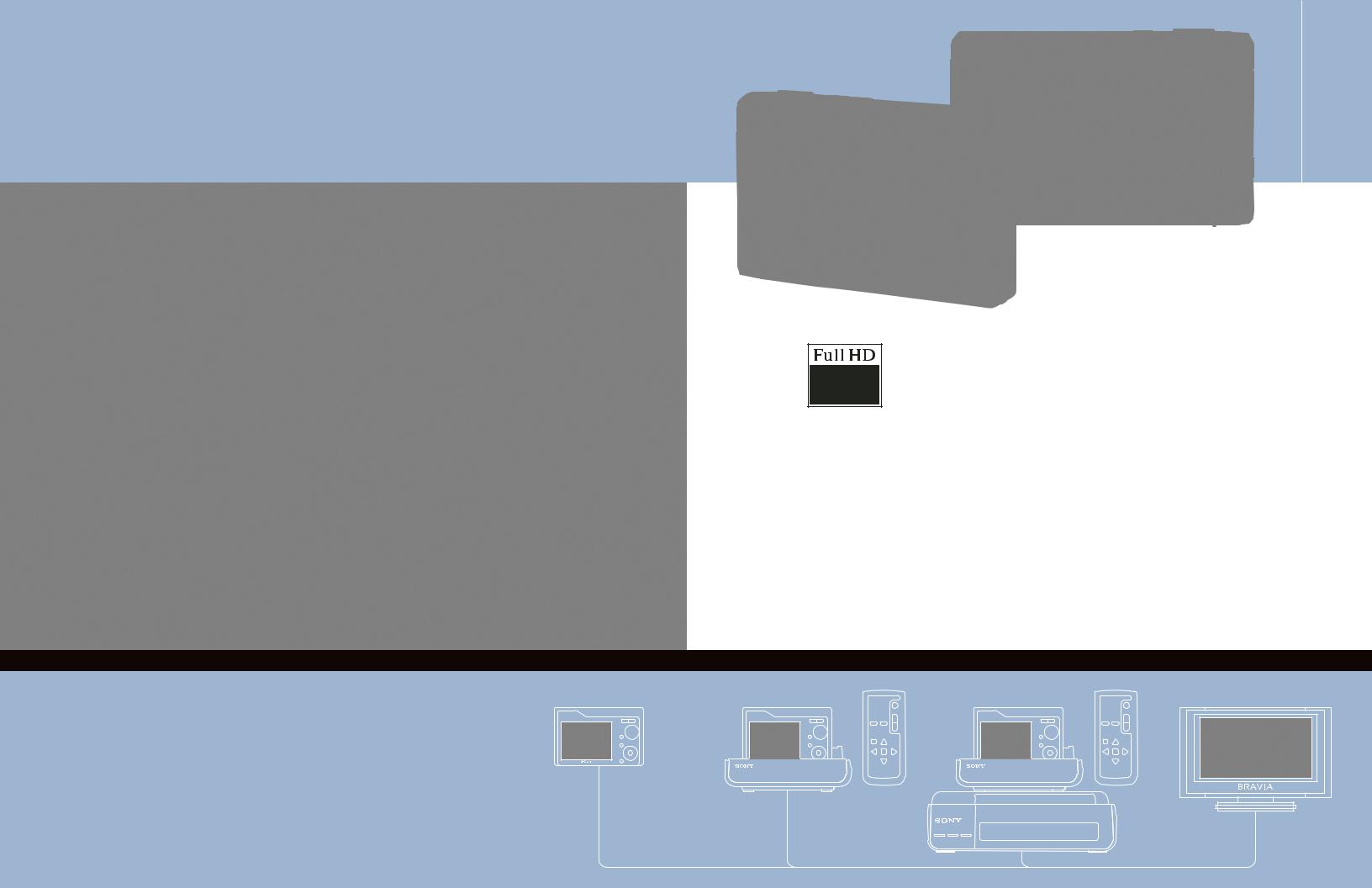
Full HD 1080
A spectacular new way to share your still pictures with the whole crowd:
on your HDTV in HD resolution!
 W80-DSC
W80-DSC
Sony has helped to deliver a brilliant new canvas on which you can share your digital pictures. It’s called HDTV and Sony is the industry leader. Thanks to the Full
HD 1080 output capability of Sony’s latest Cyber-shot® cameras, you can now enjoy your pictures with more than four times the detail of conventional, Standard Definition TV. It’s a great way to share your still pictures – and a stunning way to show off the performance of your HDTV – especially your Sony BRAVIA™ HDTV! Many cameras even offer an HD Slide Show with music. (HD connecting cables sold separately.)
Actual photo taken with a Sony® digital camera. Shutter 1/60 sec. Aperture f5.6. Flash Off. ISO 200.
FULL HD 1080
Option 1: |
Option 2: |
Option 3: |
Result: |
HD Component Cable |
HD Cradle Solution |
HD Camera/Printer Bundle Solution |
HD Photo Sharing |
Enjoy High Definition using the optional VMC-MHC1 cable, optional CSS-HD1 Cyber-shot® Station cradle or the DSC-W80HDPR bundle connected to your HDTV (sold separately). (Sample photos for illustration purposes.)
See page 44 for details
or visit www.sony.com/dsctraining.
Television, monitor and print pictures simulated.
5
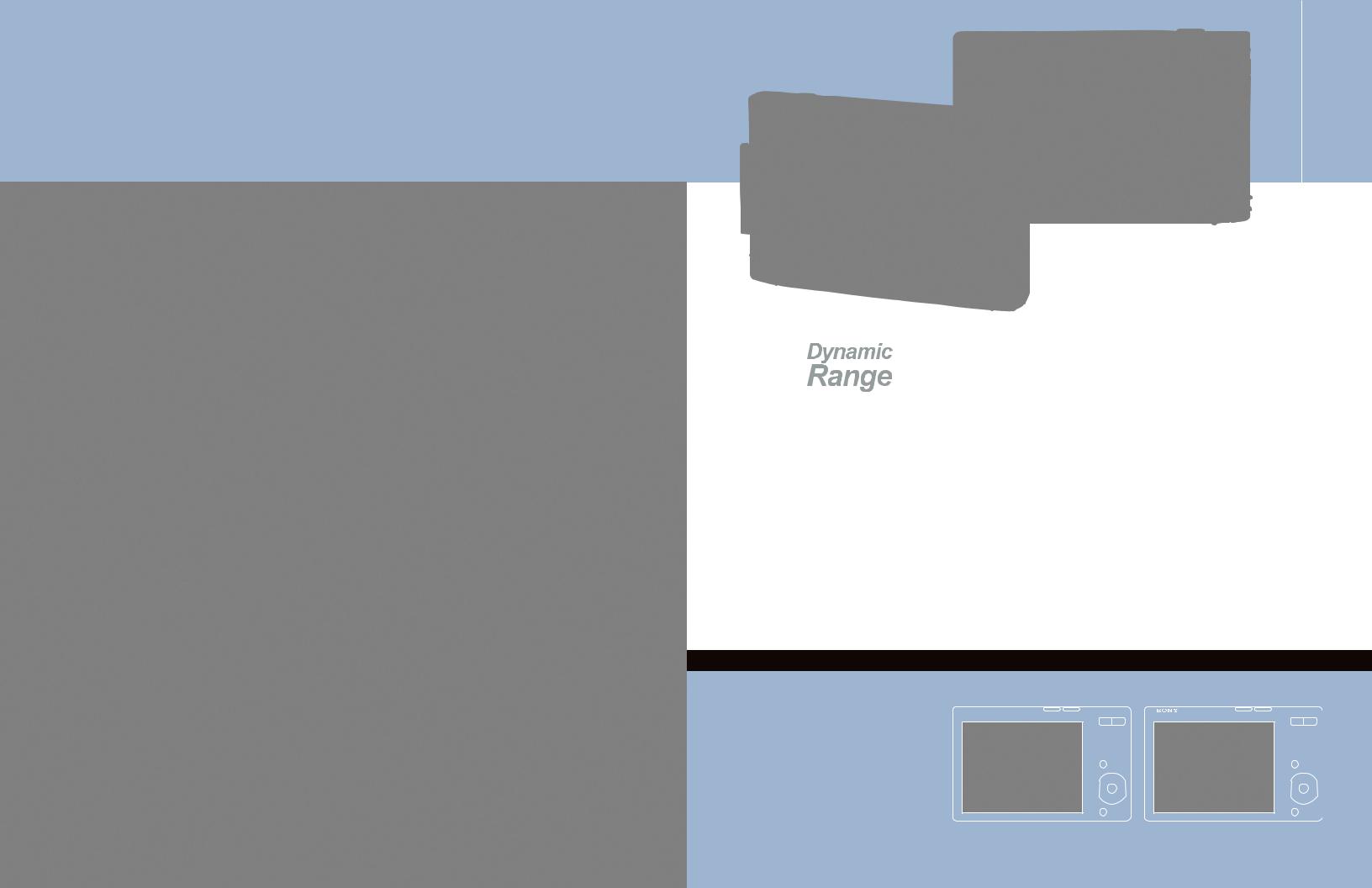
Out of the shadows
The interplay of highlights and shadows is the soul of photography. Now Sony
helps you make the most of it.
 T100-DSC
T100-DSC
Professional photographers carefully avoid exposure
mistakes like “blown out” highlights and “crushed”




 shadow detail. But sometimes, back-lighting, intense highlights and other tricky situations make these problems hard to avoid. Until now. A Sony function called Dynamic Range Optimizer (DRO) preserves highlight and shadow detail, for beautifully exposed images that are far less like snapshots, far more like what the human eye actually sees. DRO is a bit of digital wizardry made possible by Sony’s exclusive BIONZ™ processor.
shadow detail. But sometimes, back-lighting, intense highlights and other tricky situations make these problems hard to avoid. Until now. A Sony function called Dynamic Range Optimizer (DRO) preserves highlight and shadow detail, for beautifully exposed images that are far less like snapshots, far more like what the human eye actually sees. DRO is a bit of digital wizardry made possible by Sony’s exclusive BIONZ™ processor.
Actual photo taken with a Sony® digital camera. Shutter 1/80 sec. Aperture f5.6. Flash Off. ISO 200.
DYNAMIC RANGE OPTIMIZER (DRO)
The unprocessed picture (left) is marred by lost detail in both the highlights and shadows. The improvement with Sony’s DRO (right) is plain to see. (Sample photos for illustration purposes.)
See page 41 for details
or visit www.sony.com/dsctraining.
Without Dynamic Range Optimizer |
With Dynamic Range Optimizer |
Monitor picture simulated.
7
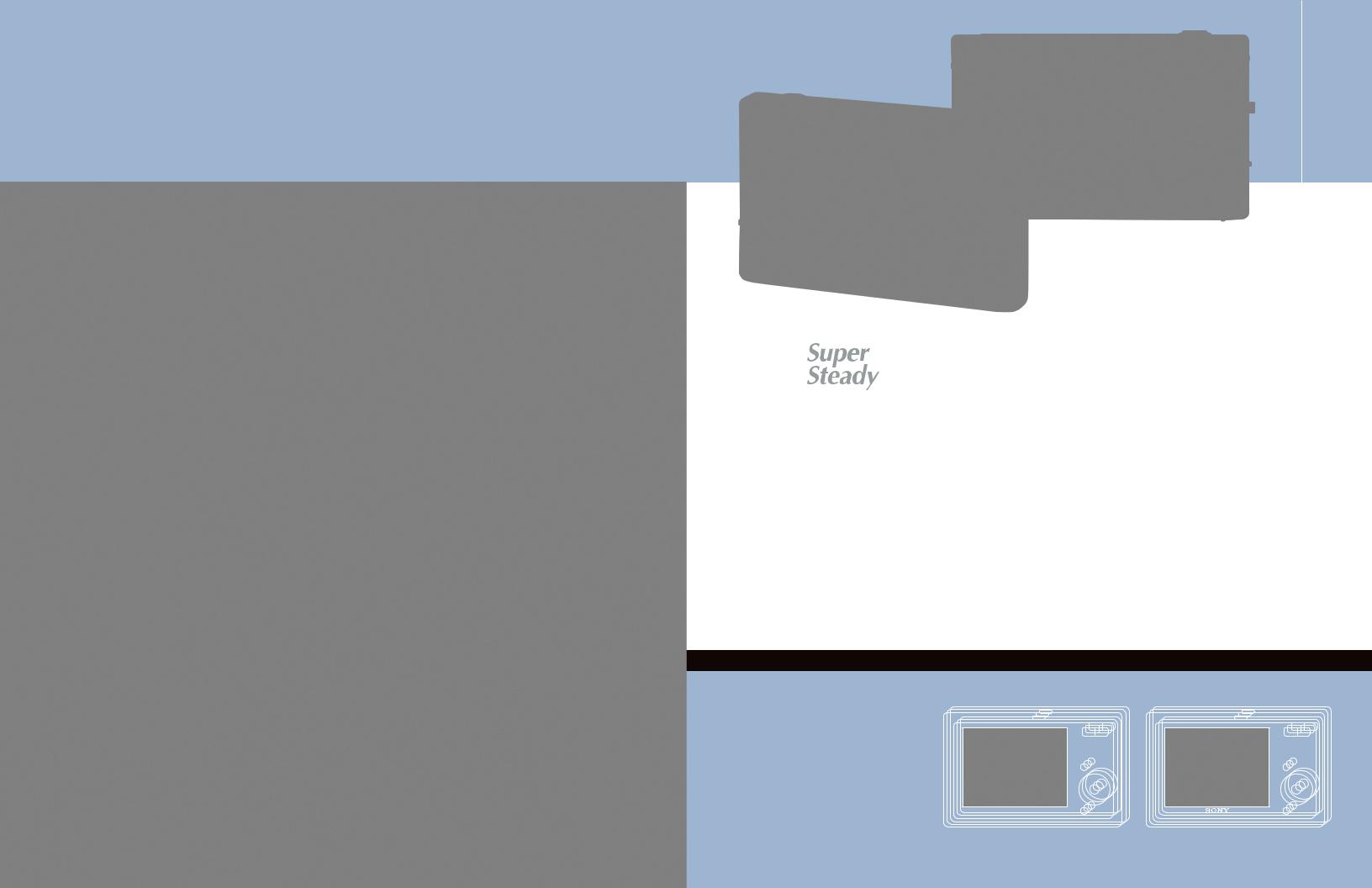
Bye-bye, blur
Handheld shots in low light have been the perfect recipe for blur. Sony uses
three powerful technologies to kiss blur goodbye.
 T20-DSC
T20-DSC
Shooting in low light means long exposure times. And
that means that even slight camera motion ends up 
 destroying the shot with blur. You could set the camera up on a tripod, but only if you have one handy! You could turn on
destroying the shot with blur. You could set the camera up on a tripod, but only if you have one handy! You could turn on
the camera’s flash, but that would spoil the mood! Sony has a better way. Our Clear RAW™ noise reduction reduces the picture “noise” common to low-light exposures. High ISO Sensitivity enables you to shoot at faster shutter speeds. And Super SteadyShot® optical image stabilization compensates for camera shake.
Actual photo taken with a Sony® digital camera. Shutter 1/8 sec. Aperture f4.5. Flash Off. ISO 400.
SUPER STEADYSHOT OPTICAL IMAGE STABILIZATION
The system uses separate vertical and horizontal sensors that detect camera shake. The camera sends an equal-but- opposite correcting signal to a stabilization lens, which moves to compensate for shake. (Sample photos for illustration purposes.)
See page 27 for details
or visit www.sony.com/dsctraining.
Without Super SteadyShot |
With Super SteadyShot |
Monitor picture simulated.
9

Get into the action
You may be on the sidelines. But your pictures can get right into the action
with Sony high zoom cameras.
 H9-DSC
H9-DSC
 Do you shoot kids’ sports? Our DSC-H7 and DSC-H9
Do you shoot kids’ sports? Our DSC-H7 and DSC-H9

 offer a 15x optical zoom lens that gets you far closer
offer a 15x optical zoom lens that gets you far closer  than conventional lenses. Since optical quality is
than conventional lenses. Since optical quality is
critical, Sony uses a Carl Zeiss® lens. Since 15x optical zoom can magnify the effect of camera shake, Super SteadyShot® optical image stabilization helps keep your pictures clearer. And since sports can mean blur, our Advanced Sports Shooting mode, intelligent continuous Auto Focus and ultra-fast 1/4000 second shutter speed deliver razor-sharp results.
Actual photo taken with a Sony® digital camera. Shutter 1/500 sec. Aperture f4.8. Flash On. ISO 160.
DIGITAL VS. OPTICAL ZOOM
Digital zoom (left) sacrifices resolution. The original pixels can become painfully obvious. Optical zoom (right) maintains the full resolution of the image sensor. (Sample photos for illustration purposes.)
See page 18 for details
or visit www.sony.com/dsctraining.
Monitor picture simulated. |
|
11 |
|
Digital Zoom |
Optical Zoom |
||
|
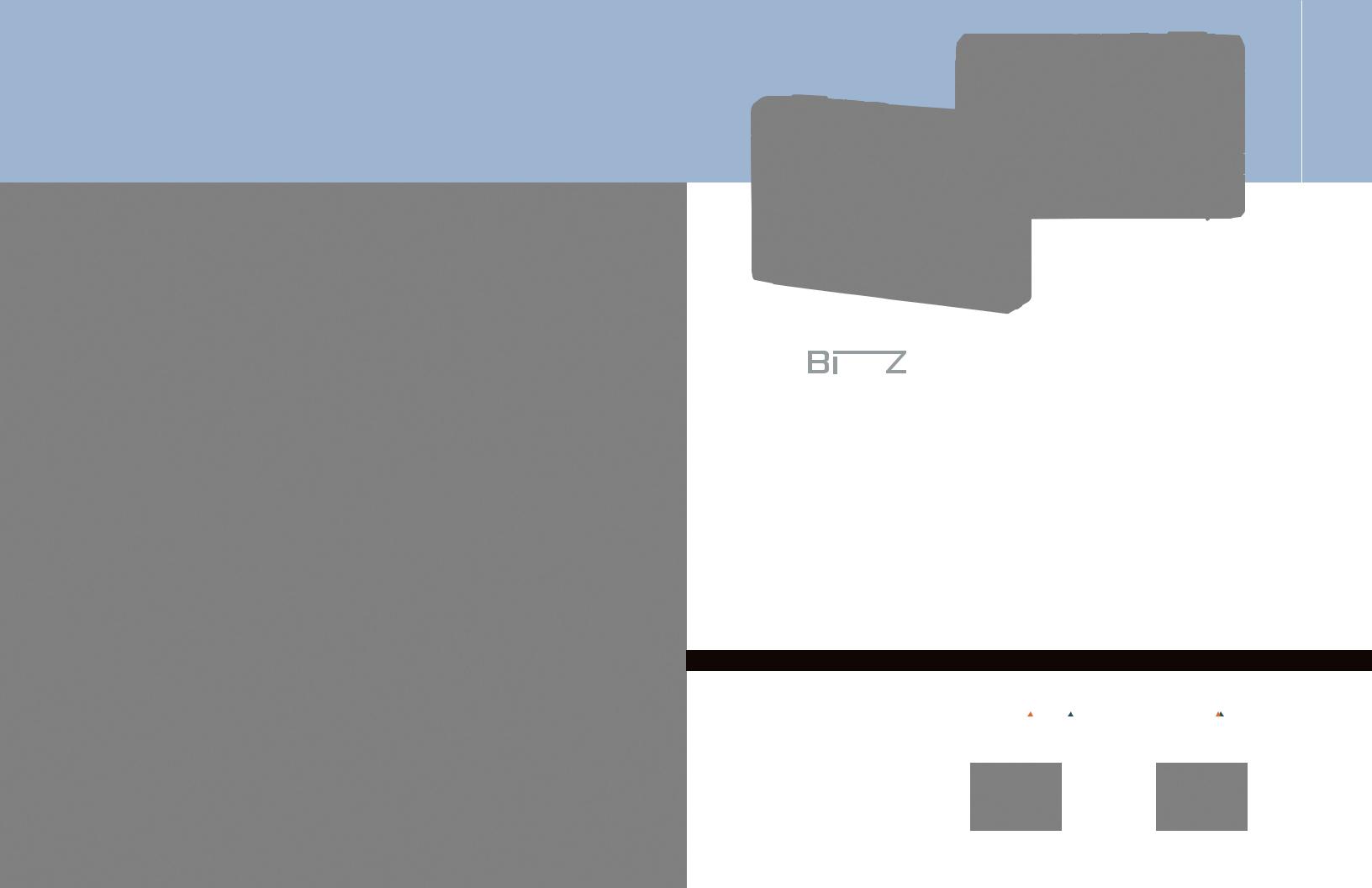
Shoot at the speed of life
Life moves fast. Thanks to the Sony BIONZ™ processor, you can catch the
most memorable moments before they pass you by.
 W90-DSC
W90-DSC
To grab a baby’s smile or a soccer goal before it’s 
 gone, your camera processor needs to be as fast as your subject. Sony’s BIONZ™ processor typically adjusts focus and
gone, your camera processor needs to be as fast as your subject. Sony’s BIONZ™ processor typically adjusts focus and
exposure in less than half a second. After that, there’s almost no “shutter lag.” The shutter typically opens less than 0.01 second after you fully press the release button. (Times vary by camera.) The power of the BIONZ processor is also the secret behind Sony Face Detection, Dynamic Range Optimizer, Full HD 1080 output and even in-camera retouching!
Actual photo taken with a Sony® digital camera. Shutter 1/1600 sec. Aperture f6.3. Flash Off. ISO 400.
BIONZ™ PROCESSOR
Shutter lag (left) could cause you to miss |
Time |
|
Processing |
|
Time |
Reduced Shutter Lag |
|||
|
|
|
|
|
|
|
|
|
|
Press Shutter Release |
Captured Image |
|
|
|
|||||
|
|
|
|
||||||
the moment. The BIONZ processor (right) |
|
|
|
|
|
|
|
|
|
reduces shutter lag to 0.01 second. (Times |
|
|
|
|
|
|
|
|
|
vary by camera.) (Sample photos for |
|
|
|
|
|
|
|
|
|
illustration purposes.) |
|
|
|
|
|
|
|
|
|
See page 26 for details |
|
|
|
|
|
|
|
|
|
or visit www.sony.com/dsctraining. |
|
|
|
|
|
|
|
|
|
Monitor picture simulated. |
|
Without BIONZ Processor |
With BIONZ Processor |
||||||
|
|
|
|
|
|
|
13 |
||
|
|
|
|
|
|
|
|
|
|

Picture perfect printing
Any printer can print your pictures. Sony printers improve them – actually
correcting defects and achieving quality that will amaze you.
 FP90-DPP
FP90-DPP
“If only.” It’s a familiar comment to anyone who prints out pictures. If only the camera’s flash hadn’t caused those ghoulish red eyes. If only the focus had been
a little better. If only the exposure had been a little brighter. Sony’s latest printers announce the end of “if only.” Thanks to the BIONZ™ processor, the printers actually analyze the content of your pictures, identify defects and correct issues in focus, exposure, red-eye* and more! We call it the Auto Touch-Up™ function. You’ll call it amazing.
AUTO TOUCH-UP FUNCTION
With the touch of a single button, Sony printers will analyze your picture data, identify faults and correct them automatically!
(Sample photos for illustration purposes.)
See page 48 for details
or visit www.sony.com/dsctraining.
Monitor and print pictures simulated. |
|
|
* Auto red-eye correction uses technology |
Without Auto Touch-Up |
With Auto Touch-Up |
from USA FotoNation Inc. |
||
|
|
15 |
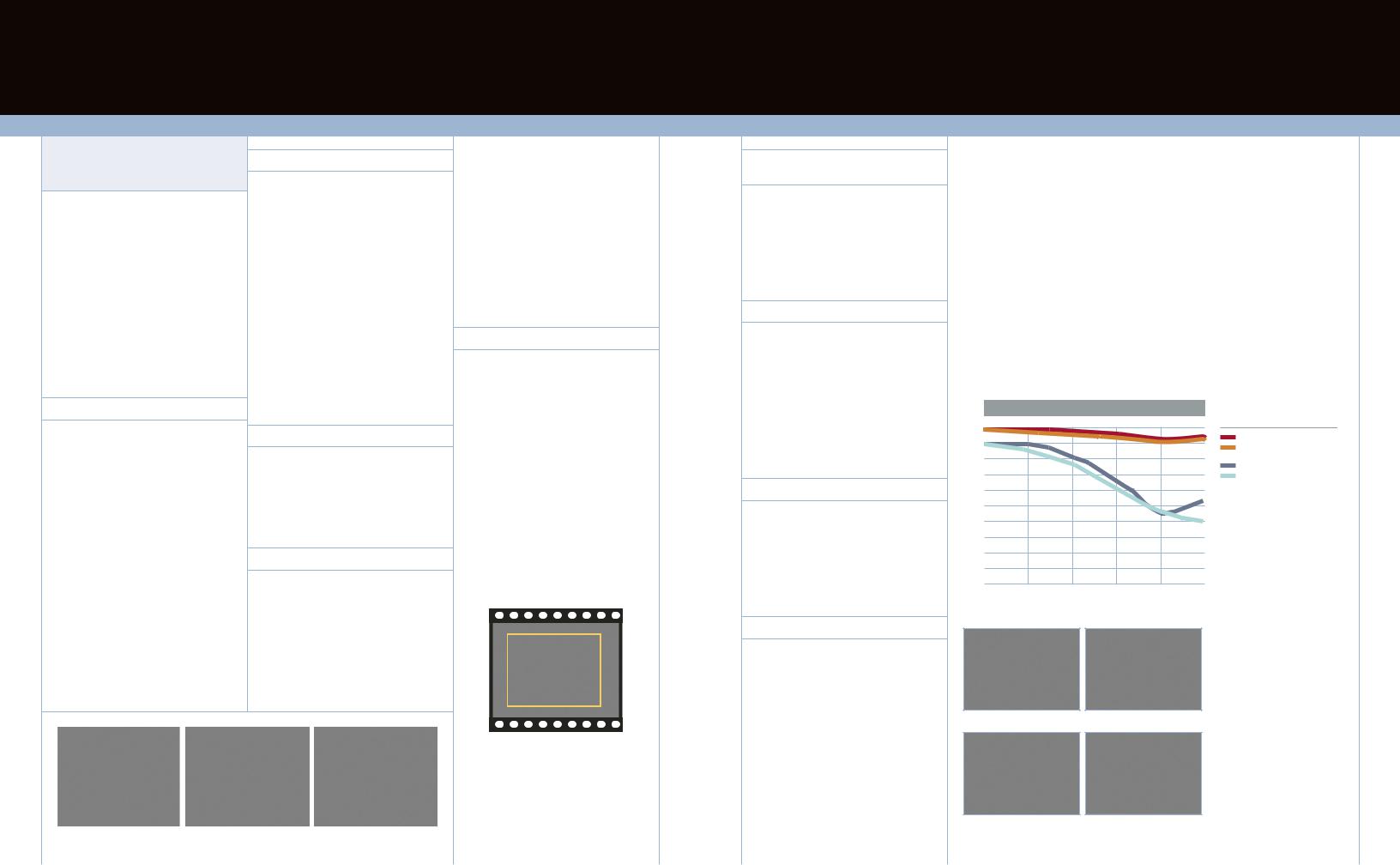
Shooting the digital way
CAMERA SYSTEMS
The lens
To the casual user, it’s obvious that
the camera takes the picture. But to
accomplished photo professionals, it’s
really the lens that takes the picture. The
lens is responsible for so much of what
defines a great image, including field of view,
focus (and the selection of what objects are
in focus), color, contrast and detail.
Focal length
The angle of view that a lens takes in is most often described by the focal length (the distance from the image sensor to the lens’s “rear nodal point”). Longer focal lengths correspond to narrower angles of view (telephoto). Shorter focal lengths correspond to wide angles of view.
In the world of 35mm film lenses, a 50mm lens approximates the angle of view of natural human vision and is considered a “normal” lens. A 28mm lens is “wide angle” and a 200mm lens is “telephoto.”
“35mm equivalence”
Unfortunately, lens focal lengths are related to image sensor sizes. And while a 35mm film frame is always the same size, digital camera image sensors vary greatly from model to model, even within a single manufacturer’s line! The same 16mm focal length that would be considered an extremely wide “fisheye” lens on a 35mm camera can actually be a telephoto lens on a compact digital camera.
To compare “apples to apples,” the industry uses a “35mm equivalent” specification that converts every lens to its equivalent 35mm angle of view – regardless of image sensor size.
Optical zoom
Optical zoom lenses are specified by a range of focal lengths, such as 24-120mm. Because the 120mm image is magnified five times compared to the 24mm image, this is also called a “5x optical zoom” lens.
Maximum aperture
The lens is like a window, admitting light. The wider the window, the more light will be let in. The width of the window is called the “maximum aperture” and it’s expressed as an “f” number, the ratio of the focal length, divided by the aperture diameter.
|
|
|
|
|
|
|
|
|
|
34mm |
|
50mm |
|
200mm |
|
|
|
|
|
Wide, normal and telephoto views of the same subject taken with 34, 50 and 200mm focal lengths (35mm equivalent). (Sample photos for illustration purposes.)
For example, a 100mm lens with a maximum aperture of 25mm is an f4. This generates the same brightness as a 40mm lens with a maximum aperture of 10mm (also f4).
The lower the “f” number, the brighter the lens. Zoom lenses are often brighter at the wide end than at the telephoto end. So it’s not unusual to see a zoom lens specification such as 28-200mm, f2-2.8.
Lens and sensor size
The lens and the image sensor work together as a team. In a fixed-lens camera, the lens is carefully tailored to the specific size and resolution of the image sensor. Small image sensors work with smaller lenses – ideal for ultra compact cameras. But if you want the higher performance and creative control of a large image sensor, you’ll need a larger lens to go with it.
The difference becomes even more dramatic in telephoto and high magnification zoom lenses. For example, the Sony DSC-H7 15x optical zoom lens extends from 31 to 465mm (35mm equivalent). On a 35mm camera, such a lens would be gigantic. Yet the DSC-H7 is quite compact.
35mm film / 24mm lens
APS-size DSLR / 38.4mm equivalent
Take a lens designed for 35mm. Put it in front of an APS-size digital image sensor. Result? A focal length conversion of about 1.5x. (Sample photo for illustration purposes.)
CAMERA SYSTEMS
Integral and interchangeable lenses
Most digital cameras have “integral” lenses, fixed to the body. Some offer interchangeable lenses that can be swapped and upgraded. Both types have their advantages and Sony makes both types. (See chart for more information.)
Resolution
When we think of digital camera resolution, we immediately think of the image sensor. But an image sensor can only resolve the detail that the lens presents. A good lens maintains high contrast at high resolution. In fact, a special family of graphic curves called the Modulation Transfer Function (MTF) describes how well a lens maintains both resolution and contrast.
Geometric accuracy
The lens is also responsible for rendering straight lines as straight. While the task seems simple enough, it is difficult to achieve at the wide end of zoom lenses, which tend toward either pincushion or barrel distortion.
Color convergence
When Isaac Newton demonstrated that a prism could break white light into its component colors, he also demonstrated what would become a drawback in lenses. Without careful correction, lenses cause colors to break apart. You can see color fringing or “chromatic aberration” as unwanted color along the edges of objects in the picture. Chromatic aberration is especially noticeable on the edges between very bright and very dark areas of the scene.
|
INTEGRAL LENS |
INTERCHANGEABLE LENSES |
|
|
|
Size |
Compact. Tailored to the specific size |
Larger. Typically optimized for 35mm image size. |
|
of the sensor. |
|
|
|
|
Zoom range |
Good. Varies by camera. Sony |
Best. Varies by lens selection. However, it’s often difficult |
|
15x optical zoom cameras have |
to get wide angle because 35mm lenses undergo a 1.5x |
|
phenomenal range from full wide |
telephoto conversion when used with the smaller, |
|
to full telephoto. |
APS-size image sensor. |
|
|
|
Live Preview |
Yes. You see what the camera sees |
No. The main image sensor is blocked by the mirror |
off the main |
on the LCD monitor, with indication |
until the moment of exposure. You frame via the optical |
image sensor |
of white balance, exposure and |
viewfinder. |
|
depth of focus. |
|
|
|
|
Versatility |
Good. Zoom lens and conversion |
Best. A selection of optional lenses gives you maximum |
|
adaptors cover many needs. |
choice. |
|
|
|
Migration |
No. The body and lens are |
Yes. As a system evolves, you may be able to keep your |
|
permanently joined. |
lenses and migrate to compatible new camera bodies. |
|
|
The a100 works with Minolta Maxxum film camera |
|
|
lenses from as far back as 1985! |
|
|
|
LENS MTF CURVES
100% |
|
|
|
|
|
90% |
|
|
|
|
|
80% |
|
|
|
|
|
70% |
|
|
|
|
|
60% |
|
|
|
|
|
50% |
|
|
|
|
|
40% |
|
|
|
|
|
30% |
|
|
|
|
|
20% |
|
|
|
|
|
10% |
|
|
|
|
|
0% |
|
|
|
|
|
0 |
3 |
6 |
9 |
12 |
mm |
DISTANCE FROM CENTER
KEY
10 Line Pairs/mm Sagittal
10 Line Pairs/mm Meridional
30 Line Pairs/mm Sagittal
30 Line Pairs/mm Meridional
This set of four MTF curves describes the ability of a lens to maintain contrast (vertical scale) across the image area (horizontal scale). As you can see, a lens can’t be described by a single resolution number.
Barrel distortion (left) and pincushion distortion (right) are inaccuracies that lenses can introduce. (Sample photos for illustration purposes.)
Chromatic aberration takes the form of unwanted color fringing, especially on the edges between very bright and very dark areas of the scene. (Sample photos for illustration purposes.)
16 |
17 |
